
| Palaeos |  |
Squamata |
| The Vertebrates | Acrodonta |
| Page Back | Unit Home | Unit Dendrogram | Unit References | Taxon Index | Page Next |
| Unit Back | Vertebrates Home | Vertebrate Dendrograms | Vertebrate References | Glossary | Unit Next |
|
Abbreviated Dendrogram
LEPIDOSAUROMORPHA |--SPHENODONTIA `--SQUAMATA |--Iguania | |--Tropiduridae | |--Acrodonta | | |--Priscagamidae | | `--+--Agamidae | | | |--Amphibolurinae | | | `--Draconinae | | `--Chamaeleonidae | `--Iguanidae `--Scleroglossa |
Contents
Overview |
In another context, we looked at the molecular phylogenetics work of J. Robert Macey and his coworkers. Cuculiformes. Dr. Macey recently (1999) completed his Ph.D. at Washington University in St. Louis, Missouri where he studied with Profs. Allan Larson and Jonathan Losos. Since we are presently on the subject of lizard phylogenies, this seemed an auspicious time to look in a bit more detail at what Macey has been doing.
In the prior discussion, we discussed Macey's work tracing phylogeny through changes in gene order in mitochondrial DNA. Macey et al (2000). Here, we examine the companion paper, in which Macey and a large group of coworkers developed trees based more conventional DNA sequencing work. Macey et al (2000a). This paper turns out the way molecular phylogenetics ought to turn out, but seldom does. The results give us a very clear picture -- not only of the phylogeny, but of the biogeography of these lizards. In truth, one suspects Macey's methods stack the deck a little, but only a little, because geography is explicitly considered in the development of the tree structure. However the correspondence of geography to genetics seems to have been statistically tested with some rigor. Surely this is no worse than the usual cladistic methods which combine genetic and morphometric information; and, in fact, the use of geographical information is just another sort of grist for the cladistic mill.
The resulting cladogram (simplified to the generic level) is as follows.
ACRODONTA
|--Chamaeleonidae (Chamaeleo)
`--+--Uromastycinae (Uromastyx)
`--+--Leiolepidinae (Leiolepis)
`--+--Amphibolurinae
| |--Physignathus cocinius
| `--+--Lophognathus
| `--+--+--Physignathus lesuerii
| | `--+--+--Arua
| | | `--Chelosania
| | `--+--Hypsilurus
| | `--Moloch
| `--+--+--Amphibolurus
| | `--Chlamydosaurus
| `--+--+--Ctenophorus
| | `--Rankinia
| `--+--+--Caimanops
| | `--Diporiphora
| `--+--Pogona
| `--Tympanocryptis
`--+--Hydrosaurinae (Hydrosaurus)
`--+--Draconinae
| |--+--+--Draco
| | | `--Japalura tricarinata
| | `--*--Otocryptis
| | `--Sitana
| `--+--Calotes
| `--+--+--Salea
| | `--+--+--Ceratophora
| | | `--+--Cophotis
| | | `--Lyriocephalus
| | `--+--+--Aphaniotis
| | | `--Gonocephalus
| | `--Bronchocela
| `--+--Acanthosaura
| `--+--Japalura flaviceps & splendida
| `--Pseudocalotes
`--Agaminae
|--Agama
`--+--+--Pseudotrapelus
| `--Trapelus
`--Laudakia (including Phrynocephalus)
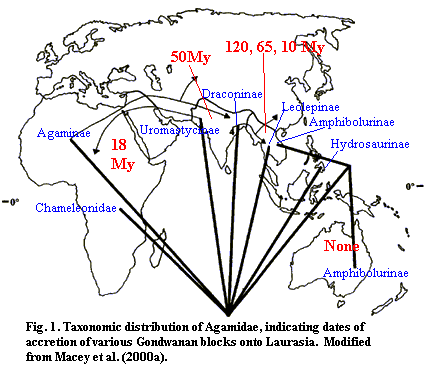 What
Macey's work suggests is that each of the various taxa of agamid
lizards crossed the Tethys on
different continental plates, like so many groups of immigrants arriving on
crowded steamers. Each of the seven major acrodont groups can be identified with
a particular fragment, or, at worst, series of fragments of the Gondwanan
plate which drifted across the Tethys Sea to contact Laurasia
(now Eurasia) over the last 120 My or so.
What
Macey's work suggests is that each of the various taxa of agamid
lizards crossed the Tethys on
different continental plates, like so many groups of immigrants arriving on
crowded steamers. Each of the seven major acrodont groups can be identified with
a particular fragment, or, at worst, series of fragments of the Gondwanan
plate which drifted across the Tethys Sea to contact Laurasia
(now Eurasia) over the last 120 My or so.
Unfortunately, when we compare the cladogram to Figure 1, it is immediately clear that there are problems. For example, the Chamaeleonidae and Agaminae are, respectively, the first and last branches from the acrodont stem. Yet they appear together on the same continental block. One very basal species of the amphibolurine (Physignathus cocinius), which presumably developed in Australia, is found in Southeast Asia. These are not insurmountable concerns, but they do suggest that the picture may not be quite as straightforward as it first appears. It would be very interesting, for example, to look at the evolution of the chameleons in a bit more detail.
Despite minor rough spots like this, the paper is a rich and elegant piece of work, and only the broad conclusions are summarized here. However, it does leave us with a real difficulty. Here is, undoubtedly, a piece of mtDNA phylogeny that worked. Why didn't it work for birds? See Mindell et al. (1997). Macey and coworkers seem to have taken a much more cautious approach to aligning the mitochondrial tRNA gene sequences which make up a large portion of the mtDNA segment used for the study. Ultimately, Macey discarded much of the tDNA sequence as "phylogenetically uninformative," primarily because it was too variable to be useful. This may, according to the views of the reader, be considered either a good use of judgment or hopelessly biased data selection.
For what it may be worth, I am inclined to the former opinion for reasons I have explained in the other essay. Proteins and tRNAs do not function as linear information. They function because of their tertiary and quaternary structure. This means that the DNA sequences coding for these structures are inter-related in ways we absolutely cannot predict from primary sequence data alone. The best we can do is to use judgment to find portions of these genes that seem to behave as if they were independent variables over the time spans of interest. The process is, even at its best, no more objective than cladistic analysis from morphological characters. That does not mean that it is worthless. It simply means that, like a lot of science, absolute and mechanical objectivity is an asymptote we must always approach without quite reaching. The greatest danger is not failing to reach it, but in believing that we already have.
Range: Africa, SE Asia, India, Indonesia, Australia
Phylogeny: Iguania : Tropiduridae + Iguanidae + * : Priscagamidae + (Agamidae + Chamaeleonidae).
Characters: $ acrodont dentition (teeth fused to top of jaw margin).
Links:Acrodonta; Herpetology: Lizards; Abstracts 49(2); Replication Slippage May Cause Parallel Evolution in the ...; Testing the Hypothesis That a Clade Has Adaptively Radiated- ...; ADW- Agamidae- Information; Evaluating Trans-Tethys Migration- An Example Using Acrodont ... (Macey paper discussed above); Evolution and Phylogenetic Information Content of Mitochondrial ... (another great paper by Macey). ATW040220.
Priscagamidae: Mimeosaurus, Pleurodontagama, Priscagama.
Range: Late Cretaceous.
Phylogeny: Acrodonta ::(Agamidae + Chamaeleonidae) + *.
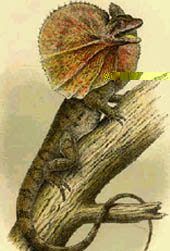 Agamidae: Small to large "Old World Iguanas."
Agamidae: Small to large "Old World Iguanas."
Range: Late Cretaceous (Campanian) to recent.
Phylogeny: Acrodonta ::Chamaeleonidae + * : Amphibolurinae + Draconinae.
Characters: Acrodont, heterodont marginal teeth; Many with dentary fangs; dentary canal for Meckelian cartilage open; adductor fossa small to moderate; palatine & pterygoid teeth absent; nasals paired; nasals contact prefrontals; frontals fused; borders of frontals constricted between orbits; broad frontal shelf below nasals; postfrontal & postorbital present as separate elements; eyelids well developed; pineal foramen present; maxilla extends back between orbits; jugal large & post-orbital bar complete; jugal-squamosal contact on supratemporal arch; supratemporal fenestra widely open; supratemporal bone present; parietals fused; opisthotic fused with exoccipital; >6 cervical vertebrae; <26 presacral vertebrae; zygosphenes & zygantra absent; moderately long tail; well-developed limbs; 5th toe absent or reduced; often conspicuously scaly; visually oriented lizards with frill, horns, bright colors common (most frequently in males); largely insectivores, but some herbivorous; generally oviparous; autotomy rare, but convergently developed in some groups as intervertebral break; autotomy septa never present; diurnal; terrestrial or arboreal.
Comments: A large and diverse family of 2 subfamilies, 52 extant genera with more than 400 species; these are small to medium-sized, terrestrial lizards, mostly insectivores, differ from the Iguanids in that their teeth are on the rims of the jaws.
Image: Chlamydosaurus kingii from the Virtual Museum of Natural History, reproduced by permission.
Links: The signal to noise ratio for websites on this taxon is particularly low. Agamidae (EMBL); Jon Loman - herp photos; Dragons of Townsville; Family: Agamidae; Agamidae; Reptilia, Squamata, Agamidae - Agamen; BEARDED DRAGON - POGONA - FROM AN AUSTRALIAN PERSPECTIVE.; LIZARDS of JAPAN; Agamidae; Agamidae.html; Agamidae Familyasi; Gli Agamidi, Agamidae (Italian); familia Agamidae; Agamidae (Dragon Lizards).
References: Caldwell (1999); Macey et al. (2000a). ATW021207.
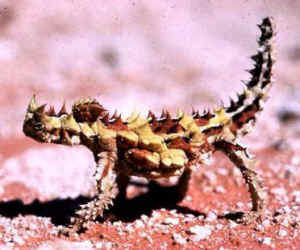 Amphibolurinae:
Physignathus, Moloch, Australian agamids.
Amphibolurinae:
Physignathus, Moloch, Australian agamids.
Phylogeny: Agamidae :Draconinae + *.
References: Macey et al. (2000a).
Links: The Reptiles of Australia, Agamid page; Moloch; Chinese Water Dragons (Physignathus Cocincinus); Digimorph - Physignathus cocincinus (Chinese water dragon); Physignathus Leseurii. ATW031026.
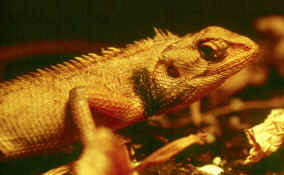 Draconinae:
Calotes, Draco, Japalura, Sitana, South Asian & Sri Lankan
agamids.
Draconinae:
Calotes, Draco, Japalura, Sitana, South Asian & Sri Lankan
agamids.
Range: from the Late Jurassic?
Phylogeny: Agamidae :Amphibolurinae + *.
Characters: "horns" (not always present, but only in draconines)
Image: Calotes versicolor from the Virtual Museum of Natural History reproduced by permission.
Notes: There is enormous variation in the members of this group, which seem more closely related by geography than by any easily determined physical characteristics. Most are long-bodied insectivores with varied spines and color display characters. The links above are only a very small sample of the resources available on the species in the taxon. ATW020720.
Links: What's It Like Where You Live?; Species: Japalura; Lizards of Japan; Species: Sitana; Bloodsucker Lizard; Agamidae; Laboratory of Animal Systematics (Japanese); CMV, Brainatlas of Calotes versicolor; changeable lizard (calotes versicolor): info fact sheet, photos; Rostral Horn Evolution among Agamid Lizards of the Genus ... (phylogeny of horns).
References: Macey et al. (2000a). ATW040707.
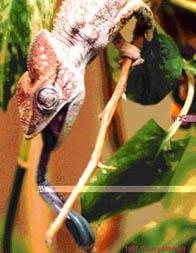 Chamaeleonidae: chameleons!
Brookesia, Chamaeleo, Furcifer
Chamaeleonidae: chameleons!
Brookesia, Chamaeleo, Furcifer
Range: from the Paleocene (Thanetian). Presently in Africa and Madagascar, with a few species in the Middle East, Asia, and Southern Europe.
Phylogeny: Acrodonta :Agamidae + *.
Characters: 2.5 - 50+ cm; Protrusible tongue; acrodont teeth, independently moveable, raised eyes; body laterally compressed; prehensile tail; digits modified for grasping (2-3 digits modified to form grasping pads); color change; often elaborately ornamented with horns, etc.; insectivorous.
Comments: about 130 extant species, about half of which are from Madagascar. Most are small insectivores, 15–25 cm long; but the smallest, the tiny Brookesia minima, is only about 3 cm long and one of the world's smallest reptiles, whereas the largest, Furcifer oustaleti (image, right), can reach over 60 cm and is known to eat small birds and other lizards. & Arboreal, tails and feet adapted for climbing, eyes able to move independently, skull may have horns or crests. Tongue half as long as animal (used to catch insects)
Links:Familia Chamaeleonidae; Marikan herppisivut (Finnish); CiN - Chameleon information NETWORK; Family: Chamaeleonidae; chameleon; The Chameleon Journals; Chameleons; JEB -- Summaries: Meyers and Nishikawa 203 (18): 2833; Chamaeleonidae.html; I Camaleonidi, Chamaleonidae (Italian); The Reptipage: Chameleons; chameleon. The Columbia Encyclopedia, Sixth Edition. 2001 Wikipedia.
Image: Furcifer oustaleti from Herp Pictures - Lizards (former site). ATW011112, modified MAK101106.
| Page Back | Unit Home | Page Top | Page Next |
checked ATW060219